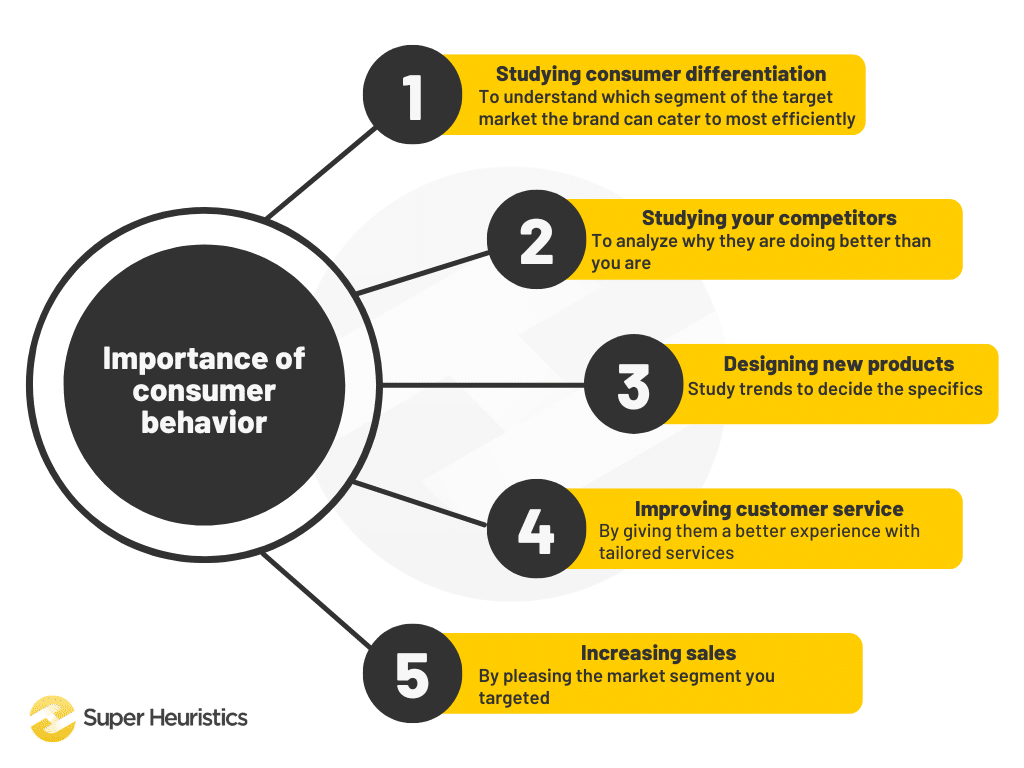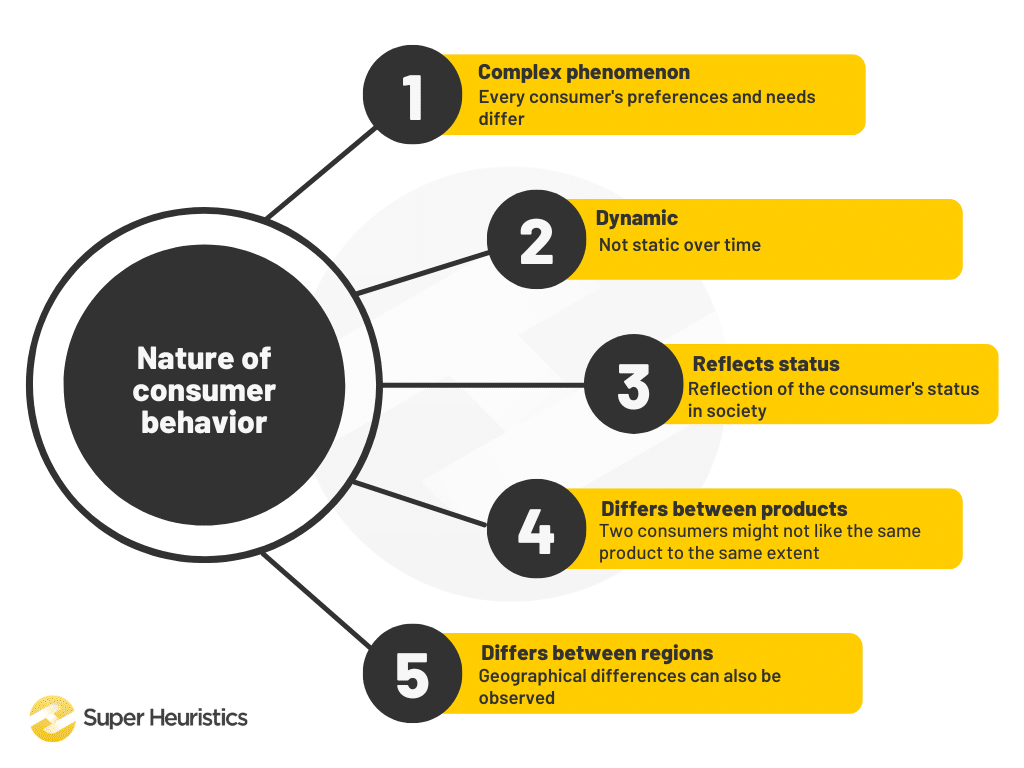Now that you’ve understood what consumer behavior is, we need to understand the nature and importance of consumer behavior.
When you went to buy your favorite instant noodles from the supermarket in the first chapter, we understood that your favorite instant noodle brand constantly uses consumer behavior to influence your decisions when buying instant noodles.
The brand knows the importance of implementing consumer behavior. It analyzes consumer behavior and manipulates the small details of its instant noodles to make it your favorite and retain that behavior.
In fact, your favorite instant noodle brand might be so efficient in implementing consumer behavior that you might not even notice other instant noodles on the shelf.
But what is the importance of consumer behavior? Why is it important to know consumer behavior? What is the relevance of consumer behavior? How will it help you become the marketer who knows the secret ingredient to attract consumers to the brand? These are the questions I will try to answer in this chapter.
Understanding the importance of consumer behavior
As we saw in the instant noodles example, the study of consumer behavior is indispensable to companies for their current and future products and services. In this section, we will see why studying consumer behavior is essential.

1. Studying consumer differentiation
The consumers in the target market of any given product or service vary in their consumer attitude. You might recall from Chapter 1 that consumer attitude has four components, namely beliefs, thoughts, feelings, and behaviors.
A marketer studies this consumer differentiation to understand which segment of the target market the brand can cater to most efficiently.
In fact, an experienced marketer may even be able to create different marketing campaigns for different segments of consumers to sell the same product or service.
Taking our instant noodles example forward, let us consider that there are two different brands of instant noodles at the supermarket. Your favorite brand knew the importance of consumer behavior, so it knew exactly what segment of the target market it was targeting.
It knows what appeals to consumers with your demographics and consumer attitude, which is why it successfully made sure your favorite instant noodles brand didn’t change.
On the other hand, the second instant noodles brand is constantly confused about the segment of the target market it wants to target. It keeps changing the packaging design, price range, and even the style of its marketing campaigns without any consistency.
As a result, its instant noodles are mostly overlooked by consumers who shop at the supermarket because even if a consumer likes the product once, it doesn’t appeal to them the next time.
2. Studying your competitors
The second reason for the importance of consumer behavior is that you need it to answer questions about your competitors. You need to study consumer behavior to analyze why your competitor has a bigger market share, which features of your competitor’s products and services appeal to the segment you are targeting too, how you can introduce those attractive features in your products, etc.,
If you use consumer behavior to understand the answers to these questions, you will be better equipped as a marketer to face your competition and maybe even drive them out of the segment you target.
If the second, less popular brand understands the importance of consumer behavior, it will be able to target the market segment it wants to capture and use consistent and more efficient marketing campaigns to appeal to that segment. Even though the effects of a good consumer behavior analysis will not be immediately visible, the brand will slowly increase its market share.
3. Designing new products
One of the most useful ways to employ consumer behavior in your company is to analyze consumer behavior while planning a new product. Study the market trends, analyze the changes in consumer attitudes, see if there has been a change in consumer perception of your brand, etc.
Use all this information to decide what your new product will be, which market segment it will be for, how to best design it, what marketing strategies will be most efficient, etc. If the possibilities are bleak for introducing new products in the same segment, the company will most likely launch the new product for another segment of the market.
For example, the second instant noodles brand might conduct market research and analyze the results only to find out that their current instant noodles would find it difficult to survive in the market because of ongoing trends. It will instead design a new product according to the current consumer attitudes in its target market segment, market trends, consumer perceptions, etc.
However, this pursuit is only going to be successful if the brand realizes the importance of consumer behavior in this exercise. Consumers are the most important stakeholders for a company. It is, therefore, important to keep in mind that their behavior can detrimentally impact the success or failure of your product or service.
4. Improving customer service
Once a company understands the differences between its different consumers, it will be able to improve its customer service to better suit the needs of its individual customers. You need to identify the needs of different consumers to understand their expectations regarding customer service.
While one consumer might need customer service for help with the product, another might only be suggesting changes in the distribution network or packaging. There are multiple other aspects in which a consumer might need customer service, and you need to understand and analyze them to give them tailored services.
For example, while you might want to get in touch with customer service to inform them about a change in taste that was least expected, your friend might want to call customer service to ask for a cashback for the same issue! Your favorite instant noodle brand will know just what to do in both those cases.
5. Last but not least - increasing sales!
This is perhaps the most important reason why a budding marketer like you should know how to use consumer behavior to its advantage. I placed it last because it’s the most obvious too.
If you efficiently and effectively employ consumer behavior tools and analyses, you will know exactly how to please the market segment you targeted. This will not only ensure that your consumers will enjoy the experience of buying your product or service once, but will bring them back for their second, third, and even fourth purchase! It is the sure-short way to increase consumer retention.
You might not even realize how subtly a brand catches your attention. Even though you might try your best to ignore billboards and advertisements of brands you don’t like, just a small glance will make you wonder about it all day long!
Your favorite instant noodle brand uses consumer behavior to do exactly this. You will find yourself singing along with its jingle, saying the dialogues out loud with the device’s volume low, or even picturing it when you think about instant noodles.
Nature of consumer behavior
Now that we’ve discussed the importance of consumer behavior, let’s briefly discuss the nature of consumer behavior. You need to understand the nature of consumer behavior so that you can find the best possible method to study it and understand more deeply why it is so important.

1. Consumer behavior is a complex phenomenon
Consumer behavior is complex because every consumer’s preferences and needs differ.
Consumer attitude and consumer perception are also very personal concepts for each individual consumer. It is, therefore, much more important to use consumer behavior in your company’s dealings to personalize each consumer’s experience with the organization to make it more enriching.
For example, you might assess portion and taste when buying instant noodles, but someone else might assess price and packaging for the same.
2. Consumer behavior is dynamic in nature
Consumer behavior is not static. It keeps changing over time for individuals and also for the entire market. Your favorite instant noodle brand might have been your least preferred brand ten years ago!
3. Consumer behavior is a reflection of consumer status
No matter what we say, our buying decisions are impacted greatly by our status in society. In the same way, our buying decisions reflect our status in society too. On the other hand, social status also impacts consumer behavior. Any change in our social status can change our consumer behavior.
Consumerism has led us to buy more and more products in an attempt to shape our image. Luxury items are considered to be a reflection of the person’s money, whereas if you drive a hatchback car, you will likely be perceived as middle-class, irrespective of how much it costs you.
While you might like to consume a brand like Nestle’s Maggi or Sunfeast’s Yippee, another consumer might like to consume Samyang Ramen or Nongshim Ramen noodles. While these might be based solely on preference, they are also a reflection of your status in society.
4. Consumer behavior differs between products
A consumer group with similar tastes and preferences might like one product, but that same product might not be appealing to another consumer group with similar tastes. This includes various decisions regarding the product - quantity, color, and even whether they buy the product or not.
For example, while you and your friends of the same demographic might love the same brand of instant noodles, your parents might not love it to the same extent as you due to differences in age, preferences, and needs.
5. Consumer behavior differs between regions
A consumer group in Delhi will not have the same consumer behavior as a consumer group in Sikkim. Taking the example of instant noodles itself, Nestle’s Maggi is the most popular brand, while Wai Wai is the most popular one in Sikkim.
With this, you know everything you need to know about the nature and importance of consumer behavior.
Conclusion and key takeaways
In this chapter, we have studied the nature and importance of consumer behavior.
To reiterate, consumer behavior is important for:
- Studying consumer differentiation
- Studying your competitors
- Designing new products
- Improving customer service
- Increasing sales
The nature of consumer behavior includes the following pointers:
- Complex phenomenon
- Dynamic in nature
- Reflection of consumer status
- Differs between products
- Differs between regions
In the next chapter, we will discuss the cultural factors affecting consumer behavior.

